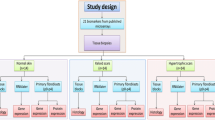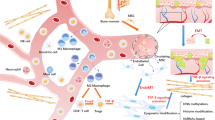Abstract
Excessive scar formation in keloids points to altered tissue modeling and repair mechanisms. Dysregulation of cytokine and apoptotic cascades and their downstream signaling pathways might have a role in keloid development. Total RNA was isolated from biopsied keloidal tissue and adjacent normal skin of black patients, white patient’s scars, and normal skin of black and white patients, with normal wound healing. Apoptosis, cytokine and NFkB pathway microarrays were used to study and compare gene expression levels. Real-time PCR was used to verify microarray results in original samples and a separate, validation-set of samples. Significant differences were observed in the expression levels of members of caspase, cytokines and MAP kinase pathways, between the normal skin of keloid-prone and normal skin of keloid-resistant patients. Specifically, expression of caspase 6, and caspase 14 genes were different between normal skin of keloid-prone individuals and normal skin of keloid-resistant patients. Our results suggest that normal skin of keloid-prone individuals constitutively expresses a distinct gene profile which might contribute to their susceptibility to develop keloids.



Similar content being viewed by others
References
Alhady SM, Sivanantharajah K (1969) Keloids in various races: a review of 175 cases. Plast Reconstr Surg 44:564–566
Akasaka Y, Fujita K, Ishikawa Y, Asuwa N, Inuzuka K, Ishihara M, Ito M, Masuda T, Akishima Y, Zhang L, Ito K, Ishii T (2001) Detection of apoptosis in keloids and a comparative study on apoptosis between keloids, hypertrophic scars, normal healed flat scars, and dermatofibroma. Wound Rep Reg 9:501–506
Bayat A, Walter JM, Bock O, Mrowietz U, Ollier WE, Ferguson MW (2005) Genetic susceptibility to keloid disease: mutation screening of the TGFbeta3 gene. Br J Plast Surg 58:914–921
Bock O, Mrowietz U (2002) Keloids. A fibroproliferative disorder of unknown etiology. Hautarzt 53:515–523
Candi E, Schmidt R, Melino G (2005) The cornified envelope: a model of cell death in the skin. Nat Rev Mol Cell Biol 6:328–340
Chen Y, Gao JH, Liu XJ, Yan X, Song M (2006) Characteristics of occurrence for Han Chinese familial keloids. Burns 32:1052–1059
Demerjian M, Hachem JP, Tschachler E, Denecker G, Declercq W, Vandenabeele P, Mauro T, Hupe M, Crumrine D, Roelandt T, Houben E, Elias PM, Feingold KR (2008) Acute modulations in permeability barrier function regulate epidermal cornification: role of caspase-14 and the protease-activated receptor type 2. Am J Pathol 172:86–97
Fernandes-AlnemriT Litwack G, Alnemri ES (1995) Mch2, a new member of the apoptotic Ced-3/Ice cysteine protease gene family. Cancer Res 55:2737–2742
Funayama E, Chondon T, Oyama A, Sugihara T (2003) Keratinocytes promote proliferation and inhibit apoptosis of the underlying fibroblasts: an important role in the pathogenesis of keloid. J Invest Dermatol 121:1326–1331
Garner WL (1998) Epidermal regulation of dermal fibroblast activity. Plast Reconstr Surg 102:135–139
Kalinin AE, Kalinin AE, Aho M, Uitto J, Aho S (2005) Breaking the connection: caspase 6 disconnects intermediate filament-binding domain of periplakin from its actin-binding N-terminal region. J Invest Dermatol 124:46–55
Katz AB, Taichman LB (1994) Epidermis as secretory tissue: an in vitro tissue model to study keratinocyte secretion. J Invest Dermatol 102:55–60
Lamkanfi M, Festjens N, Declercq W, Vanden Berghe T, Vandenabeele P (2006) Caspases in cell survival, proliferation and differentiation. Cell Death Differ 14:44–55
Lippens S, Denecker G, Ovaere P, Vandenabeele P, Declercq W (2005) Death penalty for keratinocytes: apoptosis versus cornification. Cell Death Differ 12(Suppl 2):1497–1508
Maas-Szabowski N, Shimotoyodome A, Fusenig NE (1999) Keratinocyte growth regulation in fibroblast cocultures via a double paracrine mechanism. J Cell Sci 112:1843–1853
Marneros AG, Norris JE, Olsen BR, Reichenberger E (2001) Clinical genetics of familial keloids. Arch Dermatol 137:1429–1434
Marneros AG, Norris JE, Watanabe S, Reichenberger E, Olsen BR (2004) Genome scans provide evidence for keloid susceptibility loci on chromosomes 2q23 and 7p11. J Invest Dermatol 122:1126–1132
Messadi DV, Le A, Berg S, Jewett A, Wen Z, Kelly P, Bertolami CN (1999) Expression of apoptosis genes by human dermal scar fibroblasts. Wound Rep Reg 7:511–517
Niessen F, Andriessen MP, Schalkwijk J, Visser L, Timens W (2001) Keratinocyte-derived growth factors play a role in the formation of hypertrophic scars. J Pathol 194:207–216
Pistritto G, Jost M, Srinivasula SM, Baffa R, Poyet JL, Kari C, Lazebnik Y, Rodeck U, Alnemri ES (2002) Expression and transcriptional regulation of caspase-14- in simple and complex epithelia. Cell Death Differ 9:995–1006
Quackenbush J (2006) Microarray analysis and tumor classification. N Engl J Med 354:2463–2472
Sayah DN, Soo C, Shaw WW, Watson J, Messadi D, Longaker MT, Zhang X, Ting K (1999) Downregulation of apoptosis-related genes in keloid tissues. J Surg Res 87:209–216
Sturn A, Quackenbush J, Trajanoski Z (2002) Genesis: cluster analysis of microarray data. Bioinformatics 18:207–208
Tuan TL, Nichter LS (1998) The molecular basis of keloid and hypertrophic scar formation. Mol Med Today 4:19–24
van Bokhoven H, Brunner HG (2002) Splitting p63. Am J Hum Genet 71:1–13
Vincek V, Knowles J, Li J, Nassiri M (2003) Expression of p63 mRNA isoforms in normal human tissue. Anticancer Res 23:3945–3948
Weisfelner ME, Gottlieb AB (2003) The role of apoptosis in human epidermal keratinocytes. J Drugs Dermatol 2:385–391
Xia W, Longaker MT, Yang GP (2006) P38 MAP kinase mediates transforming growth factor-beta2 transcription in human keloid fibroblasts. Am J Physiol Regul Integr Comp Physiol 290:R501–R508
Author information
Authors and Affiliations
Corresponding author
Rights and permissions
About this article
Cite this article
Nassiri, M., Woolery-Lloyd, H., Ramos, S. et al. Gene expression profiling reveals alteration of caspase 6 and 14 transcripts in normal skin of keloid-prone patients. Arch Dermatol Res 301, 183–188 (2009). https://doi.org/10.1007/s00403-008-0880-z
Received:
Revised:
Accepted:
Published:
Issue Date:
DOI: https://doi.org/10.1007/s00403-008-0880-z




